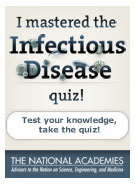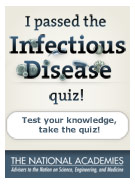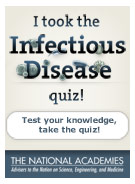
What You Need To Know About Infectious Disease
What do you know about infectious disease?
Since the beginning of the 20th century, the number of people in the world has:
-
Sorry, that’s incorrect.
Since the beginning of the 20th century the number of people in the world has more than quadrupled—from 1.6 billion to nearly 7 billion—and world population is expected to rise to well over 9 billion by 2050.
-
Sorry, that’s incorrect.
Since the beginning of the 20th century the number of people in the world has more than quadrupled—from 1.6 billion to nearly 7 billion—and world population is expected to rise to well over 9 billion by 2050.
-
Correct!
Since the beginning of the 20th century the number of people in the world has more than quadrupled—from 1.6 billion to nearly 7 billion—and world population is expected to rise to well over 9 billion by 2050.
If you have strep throat, which of the following forms of medication can be used to effectively treat the infection?
-
Sorry, that’s incorrect.
Because strep throat is caused by a bacterium called Streptococcus pyogenes, it is treatable with antibiotics but not antivirals. Currently there is no vaccine available to prevent strep throat.
-
Correct!
Because strep throat is caused by a bacterium called Streptococcus pyogenes, it is treatable with antibiotics but not antivirals. Currently there is no vaccine available to prevent strep throat.
-
Sorry, that’s incorrect.
Because strep throat is caused by a bacterium called Streptococcus pyogenes, it is treatable with antibiotics but not antivirals. Currently there is no vaccine available to prevent strep throat.
-
Sorry, that’s incorrect.
Because strep throat is caused by a bacterium called Streptococcus pyogenes, it is treatable with antibiotics but not antivirals. Currently there is no vaccine available to prevent strep throat.
About how many airline passengers cross international borders daily?
-
Sorry, that’s incorrect.
An estimated 1.8 million airline passengers cross international borders daily, creating routes by which human infections can radiate around the world within hours.
-
Sorry, that’s incorrect.
An estimated 1.8 million airline passengers cross international borders daily, creating routes by which human infections can radiate around the world within hours.
-
Correct!
An estimated 1.8 million airline passengers cross international borders daily, creating routes by which human infections can radiate around the world within hours.
Which deadly pathogen cannot be found naturally in the wild:
-
Sorry, that’s incorrect.
Smallpox cannot be found naturally in the wild. Smallpox was officially declared eradicated from the globe in 1980, after an 11-year WHO vaccination campaign—the first human disease to be eliminated as a naturally spread contagion. Today, the virus remains only in laboratory stockpiles.
-
Sorry, that’s incorrect.
Smallpox cannot be found naturally in the wild. Smallpox was officially declared eradicated from the globe in 1980, after an 11-year WHO vaccination campaign—the first human disease to be eliminated as a naturally spread contagion. Today, the virus remains only in laboratory stockpiles.
-
Correct!
Smallpox cannot be found naturally in the wild. Smallpox was officially declared eradicated from the globe in 1980, after an 11-year WHO vaccination campaign—the first human disease to be eliminated as a naturally spread contagion. Today, the virus remains only in laboratory stockpiles.
Which are larger?
-
Correct!
Bacteria are 10 to 100 times larger than viruses.
-
Sorry, that’s incorrect.
Bacteria are 10 to 100 times larger than viruses.
True or False: Infection with a pathogen (a disease-causing microbe) does not necessarily lead to disease.
-
Correct!
Infection occurs when viruses, bacteria, or other microbes enter your body and begin to multiply. Disease follows when the cells in your body are damaged as a result of infection, and signs and symptoms of an illness appear.
-
Sorry, that’s incorrect.
Infection occurs when viruses, bacteria, or other microbes enter your body and begin to multiply. Disease follows when the cells in your body are damaged as a result of infection, and signs and symptoms of an illness appear.
Due in large measure to the toll of infectious diseases, the gap in life expectancy between the richest and poorest countries now exceeds how many years?
-
Sorry, that’s incorrect.
The gap in life expectancy between the richest and poorest countries now exceeds 40 years.
-
Sorry, that’s incorrect.
The gap in life expectancy between the richest and poorest countries now exceeds 40 years.
-
Correct!
The gap in life expectancy between the richest and poorest countries now exceeds 40 years.
-
Sorry, that’s incorrect.
The gap in life expectancy between the richest and poorest countries now exceeds 40 years.
Which of the following is NOT a vector-borne disease?
-
Correct!
Influenza is not a vector-borne disease, meaning it is not transmitted to humans indirectly via an insect, an arthropod, or another animal. Malaria and yellow fever are transmitted by mosquitoes. Lyme disease is transmitted by deer ticks.
-
Sorry, that’s incorrect.
Influenza is not a vector-borne disease, meaning it is not transmitted to humans indirectly via an insect, an arthropod, or another animal. Malaria and yellow fever are transmitted by mosquitoes. Lyme disease is transmitted by deer ticks.
-
Sorry, that’s incorrect.
Influenza is not a vector-borne disease, meaning it is not transmitted to humans indirectly via an insect, an arthropod, or another animal. Malaria and yellow fever are transmitted by mosquitoes. Lyme disease is transmitted by deer ticks.
-
Sorry, that’s incorrect.
Influenza is not a vector-borne disease, meaning it is not transmitted to humans indirectly via an insect, an arthropod, or another animal. Malaria and yellow fever are transmitted by mosquitoes. Lyme disease is transmitted by deer ticks.
Of the more than 1,700 known viruses, bacteria, and other pathogens that infect people, how many have come from animals?
-
Sorry, that’s incorrect.
More than half of the known pathogens that infect people have come from animals. Of the 37 new infectious diseases identified in just the past 30 years, two-thirds sprang from animals.
-
Sorry, that’s incorrect.
More than half of the known pathogens that infect people have come from animals. Of the 37 new infectious diseases identified in just the past 30 years, two-thirds sprang from animals.
-
Correct!
More than half of the known pathogens that infect people have come from animals. Of the 37 new infectious diseases identified in just the past 30 years, two-thirds sprang from animals.
Thank you for taking our quiz.
Place this badge on your Facebook page to show your friends what you know about infectious disease.
Place this badge on your Facebook page to show your friends what you know about infectious disease.
OR, get a higher score to unlock a different badge.
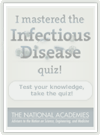
Place this badge on your Facebook page to show your friends what you know about infectious disease.
OR, get a higher score to unlock a different badge.
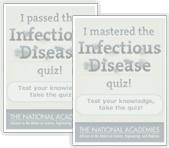
Explore Other Topics
Disease Watchlist
Infectious Disease Defined
- Staph Infection
An infection caused by any one of several harmful species or subspecies of bacteria of the genus Staphylococcus.
